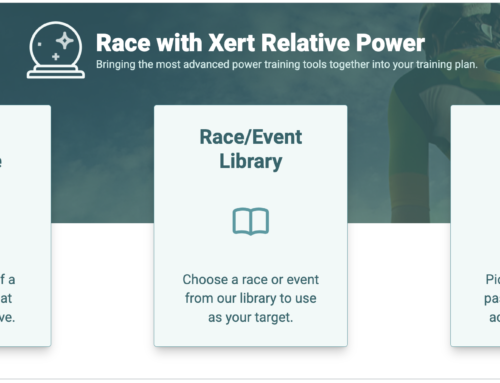Introduction
With the creation of the Adaptive Training Advisor, Xert has radically changed the way in which we train & prepare for events. Rather than prescribing workouts weeks & months in advance, Xert takes a day-to-day approach for workout recommendations. Xert’s recommendations are based on a variety of factors that you have control over, including your Athlete Type & Improvement Rate. In this blog post, we will discuss how you can utilize Xert to help you prepare for your Target Event and what to do leading up to the day of the event itself.
Understanding the Demands of your Event
The first step to arriving ready to rock on your event day is having a good understanding of what it will take to succeed in the event. Will your event require high-power sprints out of corners at a crit? Short, hard efforts up key hills in a road race? Perhaps there will be plenty of longer climbs. Ask yourself these questions so you can select the appropriate athlete type. Your athlete type is an important aspect of your training program, since it influences the overall periodization of your training program, which we will cover in detail in the next section.
In general, the Athlete Types can be roughly divided into four main groups:
- Sprinters: Power Sprinter, Road Sprinter, Pursuiter
- Attackers: Puncheur, Breakaway Specialist
- All-Rounders: Rouleur, GC Specialist, Climber
- Endurance: Sprint Time-Trialist,Time-Trialist, Century Rider, Triathlete
For most athletes, selecting an athlete type from the Attacker group will be sufficient. However, you should review activities that are similar to your target event and look at their Focus Duration – select the matching athlete type.
To learn more about this, read our related blog post here
Another aspect to consider is the amount of training load that is required for your event. The longer or harder your event is, the higher the training load will be required to effectively compete. Ideally, your training load should be at least 1/3 the amount of XSS you might expect to do on event day. For example, if the event will generate 300 XSS, you should ideally be at 100TL just prior to the event and fresh for best results.
Periodization and Xert
Periodization refers to the systematic planning of training into discrete training periods. Your training program with Xert is divided into four phases: Base, Build, Peak, & Taper. As discussed above, your adaptive training is periodized according to your athlete type.
Those of you who are training for a particular event, you will notice that the focus type of recommended workouts will change as you progress through the Xert Adaptive Training Program. This generally involves more low-intensity & endurance early in your training program and transitioning into highly specialized workouts later in the program. You can visualize this as a pyramid, where the base of the pyramid is a strong base period, and the top of the pyramid is highly specialized training:

This concept of increasing intensity is often referred to as increasing specificity, meaning that the closer you are to your event, the more your training should mimic the demands of your event. Intuitively, this makes sense – the final weeks of your training should be focused on improving the fitness demands of your event. For example, if your event requires top end sprint power, the final weeks of training should include activities & workouts with a Road Sprinter focus type. Those final weeks are not the time to be focused on Threshold Power or 5 minute power – those areas of fitness should have already been developed earlier in the training program. Next up, we’ll discuss the various training phases that Xert will lead you through on the way to your target event, and what you can expect out of each phase of your training.
Pro Tip: Training phases are unique to the Target Event Date program type. Xerters who have selected Continuous Improvement or Challenge will not progress through different training phases.
How Xert Periodizes your Training Phases
Xert’s Adaptive Training Program for a Target Event begins 120 days prior to your goal event. Over those ~4 months, Xert will move you through Base, Build, Peak, and Taper phases. If your target event is more than 120 days away, you’ll begin your training program in the Pre-Base phase. You can view your current position in your training program by heading to the “Training” tab of XertOnline.com and scrolling down:
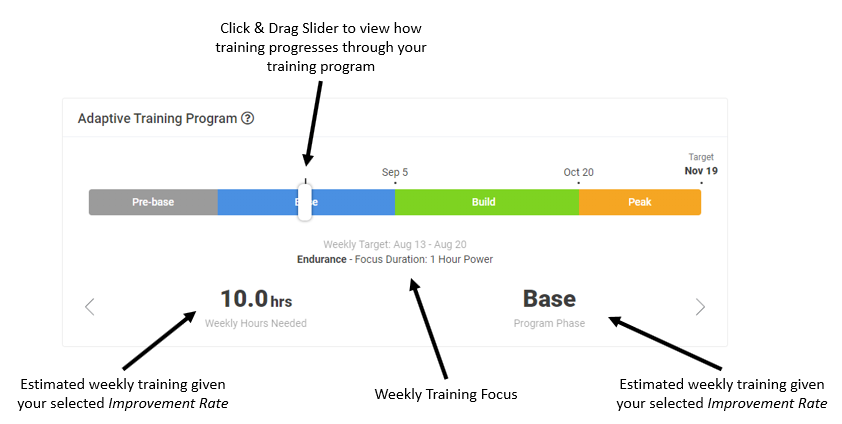
Your current training phase and estimated weekly volume of training for your current Improvement Rate is displayed below. You can click & drag the slider to view how your recommended training & weekly volume will change as you progress through your program. Also note how your weekly Focus changes through the build & peak phases.
Pre-Base Phase (If Applicable)
Xert will place you in the pre-base phase if your target event is more than 120 days away. In this training phase, you still have plenty of time until your event day, so the exact workout that you choose will not have a material difference to your target event. When your training status is Fresh or Very Fresh (Blue/Green Stars), Xert will recommend a high-intensity workout that aligns with your selected athlete type – e.g. a Puncheur will be recommended Puncheur focus workouts. When your training status is Tired (Yellow stars), Xert will recommend endurance focused workouts with a 2.5 diamond difficulty or less.
Base Phase
The primary focus of the base phase is to develop your low-intensity training load, which helps your Threshold Power . This becomes important, since having a deep aerobic base will allow you to recover faster from high-intensity training later in the program. In this phase, Xert will always recommend endurance-focused workouts. If you would like to include some high intensity training into your base phase, feel free to filter for higher intensity workouts when your training status is Fresh/Very Fresh (Blue/Green stars). When yellow, Xert will still recommend endurance workouts with a 2.5 diamond difficulty or less.
Build Phase
In the build phase, Xert continues to build your endurance while beginning to develop your high & peak intensity systems. If you’re looking at the Adaptive Training Program and move the slider forward through the build phase, you should notice that the weekly training recommendations will change.
Early in the build phase, Xert will still recommend endurance-focused workouts, even when your training status is Fresh. Your selected athlete type will make a larger influence in the mid-build phase. Endurance oriented athlete types (GC Specialist, Climber, Sprint Time-Trailist, Time-Trialist, Century Rider, & Triathlete) will see harder endurance workouts recommended, while attackers (Puncheur, Breakaway Specialist, & Rouleur) and sprinters (Power Sprinter, Road Sprinter, & Pursuiter) will start to see more intense workouts recommended. These differences between different athlete types are highlighted in the image below:
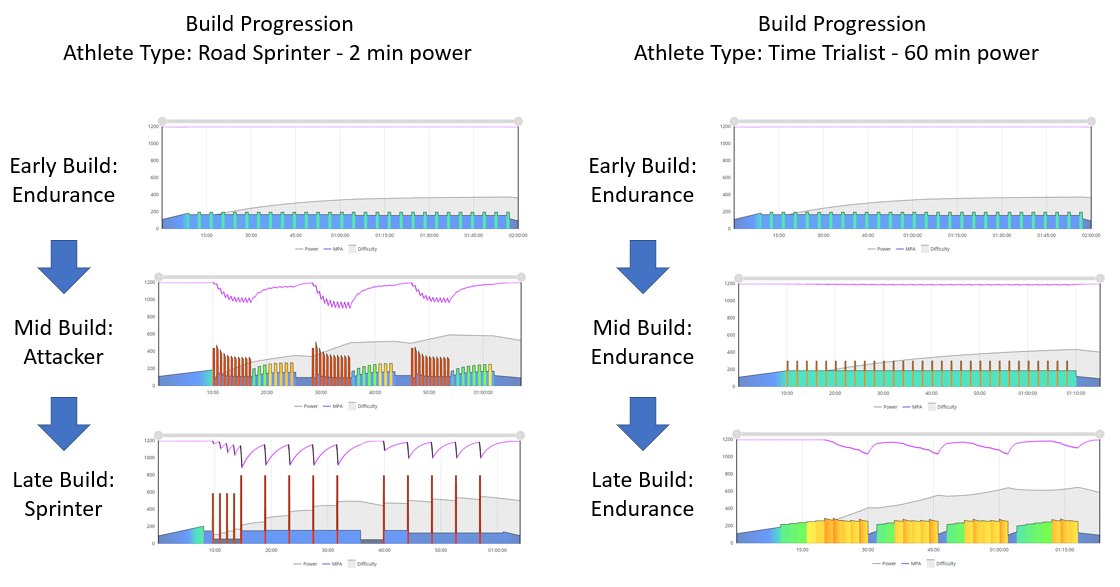
Longer focus duration athlete types (Time Trialist, Century Rider, and Triathlete) will be recommended athlete specific workouts, but those workouts will appear as “endurance” in the Xert system. This is demonstrated on the right-hand side of the image above. On the other hand, attackers & sprinters will experience a greater progression as the weekly focus shifts from endurance towards their selected athlete type. This is demonstrated on the left-hand side of the image above.
Pro Tip: The average athlete should avoid choosing longer duration athlete types, such as Time Trialist, Century Rider, or Triathlete unless they are aiming to only compete in these events.
Peak Phase
In the Peak Phase, Xert works to increase the specificity of your training, meaning that the workouts that are recommended will closely align with your selected athlete type. You should notice in this phase of training that, when your training status is Fresh, the HIIT workout recommendations should generally match your selected Athlete Type. For example, a puncheur athlete will receive recommendations to help improve their 4 min power (Puncheur athlete type), while a Road Sprinter will be recommended workouts to help improve their 2 min power (Road Sprinter athlete type).
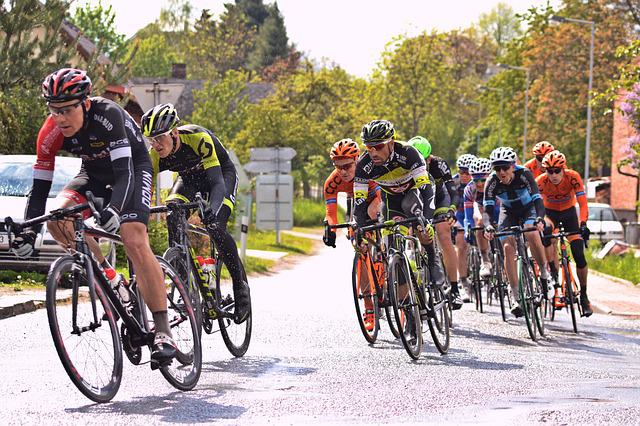
Taper Phase
The taper period is your final training phase before your target event. During the taper period, the goal is to reduce your overall weekly XSS & hourly training, whilst maintaining peak intensity. In Xert terms, this means reducing your Improvement Rate to “Taper” or even “Off-Season”, while still completing high-intensity workouts with a focus that aligns with selected Athlete Type. This process will be outlined in detail in the next section.
Perfecting Your Taper
There are two important things to understand about a taper period:
- There are no specific steps & workouts leading up to your event. Every taper should be different, depending on a variety of factors.
- The Taper period requires flexibility! Your training plan should change on a daily basis depending on how you’re feeling, while being aware of your training status leading into your event.
Although every taper is slightly different (depending on the athlete & target event), the ultimate goal is to arrive on the day of your event fresh & ready to perform! Xert’s Fitness Planner is an indispensable tool for helping you perfect your taper, since you can experiment with different workouts & days in the taper period and see its effect on your Target Event Day readiness without actually doing them! Follow these general guidelines to experiment & plan your taper:
Step 1. Start by reducing your Improvement Rate to Taper. This reduces the total amount of training that Xert will recommend, allowing you to freshen up for your target event.
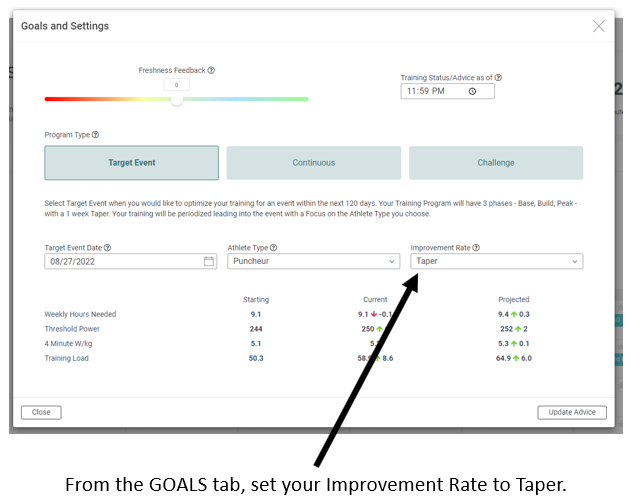
Step 2. Next, place one of the SMART - Opener workouts a day or two before your target event. Choose the Opener workout that suits your Athlete Type (Sprinter, Attacker, etc).
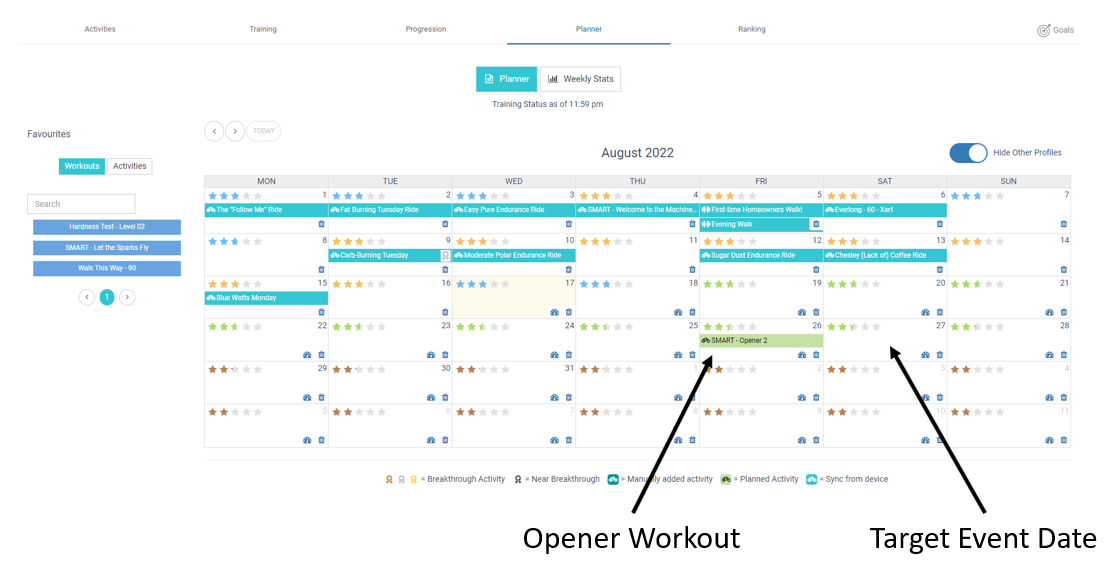
Step 3. Once that’s done, start working from today’s date forward, select a HIIT workout when your training status is Fresh. You can either drag & drop easier endurance workouts (e.g. SMART - Lucy In the Sky With Diamonds) when your training status is tired, or click on the date to view the recommended workouts. In general, we recommend against letting Xert automatically select your workouts during the taper period. You will have an increased awareness of how you feel in preparation for your event by manually planning & selecting workouts based on how you're feeling each and every day.
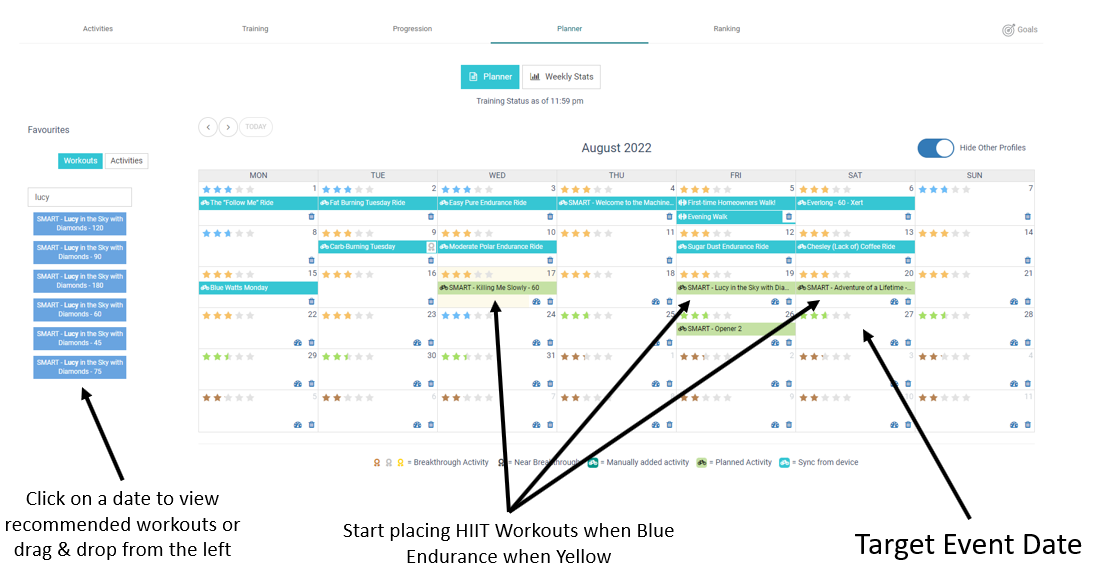
Step 4. As you start placing workouts in the fitness planner, pay special attention to your expected training status just before your target event. You can even change your As Of time for - ideally your training status should be Fresh (blue stars) on your target event date. Continue to experiment with your taper by repositioning HIIT workouts and endurance rides by clicking & dragging them in the planner:
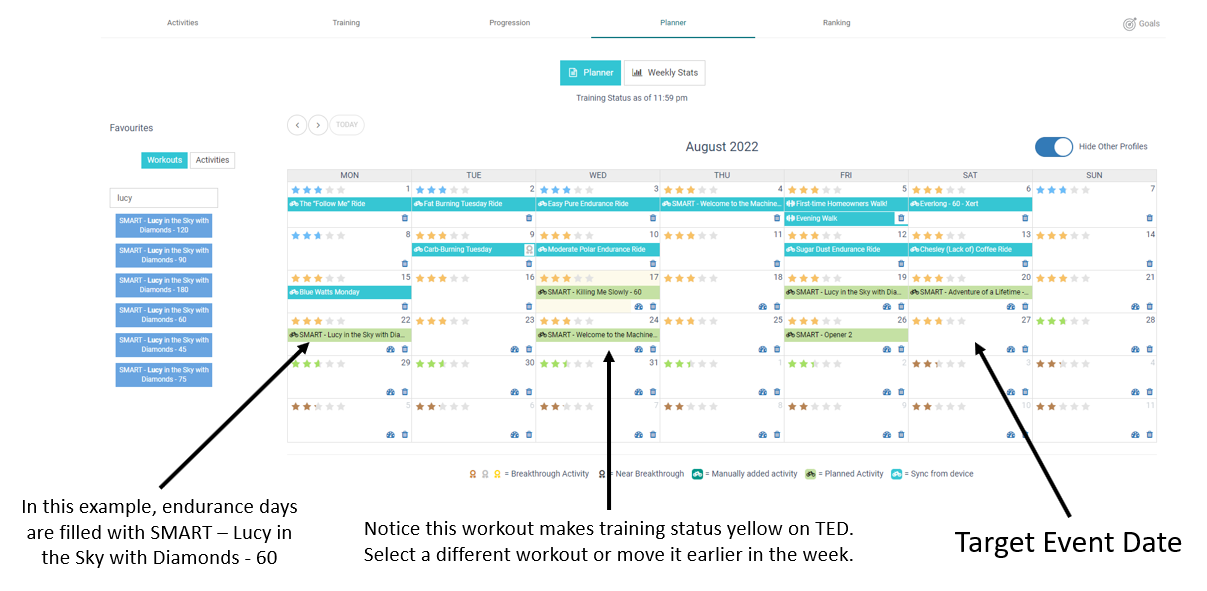
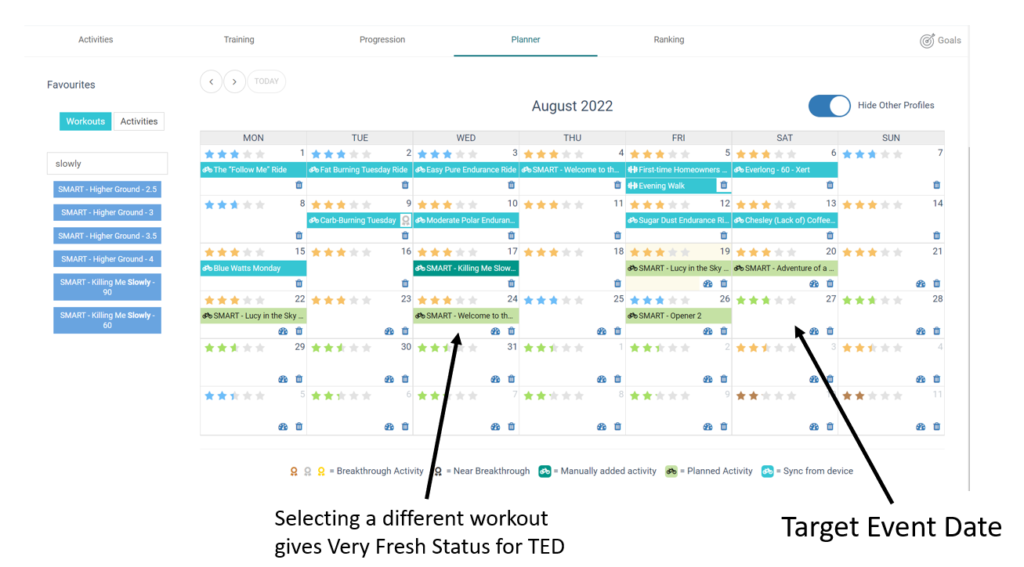
Step 5. You can also use the same method to determine how much training you should be doing for an event. By reviewing your training status after the event and inspecting how fatigued you will be, you can help gauge whether you are trained enough for the event. As a rule of thumb, most shorter (~2 hour) events should leave you yellow afterwards. A red status after the event indicates you may not be adequately trained for the event. This rule of thumb does not apply to ultra (160+ km) or multi-day events.
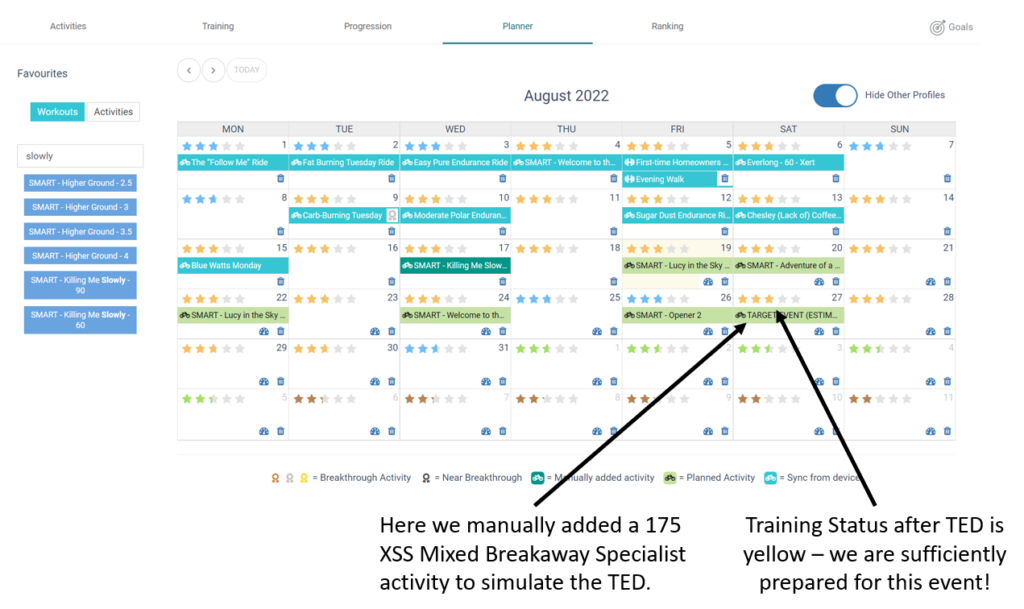
Conclusion
In this blog post, we covered many of the essential aspects to help you train right up to your event. Your selected Athlete Type influences the overall periodization of training as progress from Build through Peak phase. Your training status, as well as your training phase, will determine the recommended workouts on a daily basis. The final taper helps you freshen up for your event, so you feel ready to go for your target event. Use some of the information we have provided to help plan & prepare for your next event. There is nothing quite like lining up at the start line feeling as prepared as you can be! Happy Xerting!


